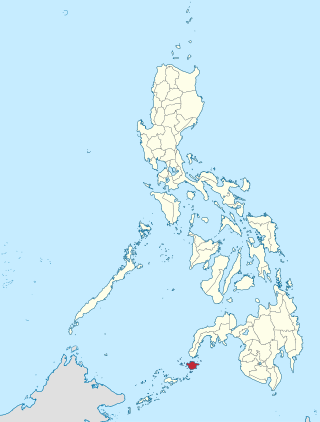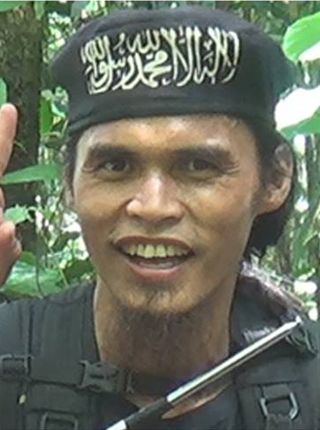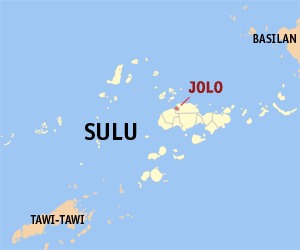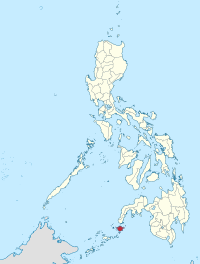
Abu Sayyaf, officially known by the Islamic State as the Islamic State – East Asia Province, was a Jihadist militant and pirate group that followed the Wahhabi doctrine of Sunni Islam. It was based in and around Jolo and Basilan islands in the southwestern part of the Philippines, where for more than five decades, Moro groups had been engaged in an insurgency seeking to make Moro Province independent. The group was considered violent and was responsible for the Philippines' worst terrorist attack, the bombing of MV Superferry 14 in 2004, which killed 116 people. The name of the group was derived from Arabic abu, and sayyaf. As of April 2023, the group was estimated to have about 20 members, down from 1,250 in 2000. They used mostly improvised explosive devices, mortars and automatic rifles.

Khadaffy Abubakar Janjalani was a Filipino Islamist militant who was the leader of the Moro militant group known as Abu Sayyaf and the leader of one of its factions. He was a staunch Wahhabi follower.
The Dos Palmas kidnappings was a hostage crisis in southern Philippines that began with the seizing of twenty hostages from the affluent Dos Palmas Resort on a private island in Honda Bay, Palawan, by members of Abu Sayyaf jihadist group on May 27, 2001, and resulted in the deaths of at least five of the original hostages. Three of the original hostages were American citizens, Guillermo Sobero, and a married missionary couple, Martin and Gracia Burnham. At least 22 Filipino soldiers were killed in attempts to apprehend the captors and free the hostages in the 12 months following the initial hostage taking. An unknown number of captors were killed by government forces.

The Moro conflict was an insurgency in the Mindanao region of the Philippines which involved multiple armed groups. A decades-long peace process has resulted in various peace deals have been signed between the Philippine government and two major armed groups, the Moro National Liberation Front (MNLF) and the Moro Islamic Liberation Front (MILF), but other smaller armed groups continue to exist. In 2017, the peace council settled around 138 clan conflicts.

Isnilon Totoni Hapilon, also known by the nom de guerreAbu Abdullah al-Filipini, was a Filipino Islamist militant affiliated with ISIS. He was formerly leader of Abu Sayyaf Group, before its battalions pledged their allegiance to Abu Bakr al-Baghdadi. An April 2016 issue of ISIL's weekly newsletter Al Naba said that Hapilon had been appointed as "emir of all Islamic State forces in the Philippines".

Jainal Antel Sali Jr. was a Filipino militant who was a senior leader of Abu Sayyaf, an Islamist terrorist organization affiliated with Al Qaeda.

The 2007 Basilan beheading incident was an armed incident that took place in July 2007 between the Moro Islamic Liberation Front (MILF) rebels and the Philippine Army. The incident led to the execution of 14 or 23 members of the Philippine Marines; amongst them 11 were beheaded in the province of Basilan, which is located within the southern Philippines.
The civil conflict in the Philippines as of February 2019, consists of an insurgency pitting government forces against Maoist rebels, that began in 1969 during the rule of Ferdinand Marcos.

Battle of Basilan was a military offensive launched by the Philippine military to apprehend two lead commanders in the Abu Sayyaf Islamic militia wanted for corruption, money laundering, and terrorism related charges. The main cause of the operation was Sayyaf leader Indama and his followers threatening and attempting to extort money from a circumferential road network. The two-day offensive ended with both suspects evading capture and the island of Basilan falling under government authority. Both the army and MNLF collaborated in fighting alongside for a duration of the operation the first such instance since a truce. However collaborators within the Sayyaf militia included members of the MNLF who sympathized with their cause or had public relations with some of the militants.
This article contains a timeline of events from January 2016 to December 2016 related to the IS-linked Abu Sayyaf. This article contains information about the events committed by or on behalf of the Abu Sayyaf, as well as events performed by groups who oppose them.
The following is a list of attacks which have been carried out by Abu Sayyaf, a militant group based in and around Jolo and Basilan islands in the southwestern part of the Philippines, where for more than four decades, Moro groups have been engaged in an insurgency for an independent province in the country.

Dawlah Islamiya, also called Islamic State of Lanao and formerly named as the Maute Group, is a radical Islamist group composed of former Moro Islamic Liberation Front guerrillas and foreign fighters. Based in Lanao del Sur, it was founded by brothers Abdullah and Omar Maute. The organization, which also conducted a protection racket operation in the municipality of Butig, clashes on several occasions with the Armed Forces of the Philippines, the most significant of which began in May 2017 and culminated in the siege of Marawi.

The siege of Marawi, also known as the Marawi crisis and the Battle of Marawi, was a five-month-long armed conflict in Marawi, Philippines, that started on May 23, 2017, between Philippine government security forces against militants affiliated with the Islamic State (IS), including the Maute and Abu Sayyaf Salafi jihadist groups. The battle also became the longest urban battle in the modern history of the Philippines.

Omarkhayam Romato Maute was a Filipino Islamist militant who co-founded, along with his brother Abdullah Maute, a Dawlah Islamiyah group in Mindanao based in the Philippines, commonly known as the Maute group after their surname.

The Summer 2016Sulu and Basilan clashes were armed conflicts that took place in two battlefronts on the southern islands of Mindanao, Philippines from 21 June to 12 July.
The Philippines is one of the state opponents of the militant group, Islamic State of Iraq and the Levant (ISIL), more commonly referred to by the local media as the Islamic State of Iraq and Syria (ISIS).
This is a chronology of the Moro conflict, an ongoing armed conflict in the southern Philippines between jihadist groups such as the Abu Sayyaf Group, the Maute Group, Jemaah Islamiyah, and Islamic State affiliates, mainstream separatist groups such as the Moro Islamic Liberation Front (MILF), the Moro National Liberation Front (MNLF) and the Bangsamoro Islamic Freedom Fighters (BIFF), and the Philippine Government since 1971. Much of the fighting has been concentrated on the island of Mindanao and the Sulu archipelago, with spillover incidents and attacks occurring in the Philippine capital Manila and neighboring countries such as Malaysia.
On July 31, 2018, a bomb exploded in the town of Lamitan in Basilan, Philippines.
Hatib Hajan Sawadjaan was a Filipino militant affiliated with the Abu Sayyaf. He was the leader of the group which has associated itself with the Islamic State of Iraq and the Levant (ISIL) since 2014. On July 6, 2020, Hajan Sawadjaan was severely wounded during an encounter with the government troops in Barangay Bakong, Patikul, Sulu and died from his injuries a few days later. After the encounter with the government troops, he was found and buried by the group of his cousin Mundi Sawadjaan, an Abu Sayyaf sub-leader.
The 2020 Jolo bombings occurred on August 24, 2020, when insurgents alleged to be jihadists from the Abu Sayyaf group detonated two bombs in Jolo, Sulu, Philippines, killing 14 people and wounding 75 others. The first occurred as Philippine Army personnel were assisting in carrying out COVID-19 humanitarian efforts. The second, a suicide bombing, was carried out near the Our Lady of Mount Carmel Cathedral.










